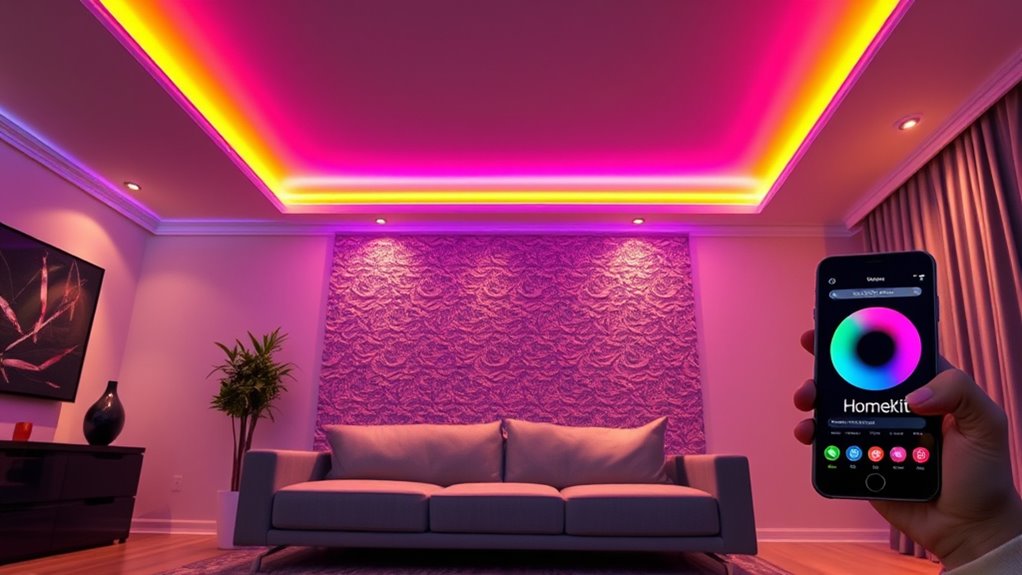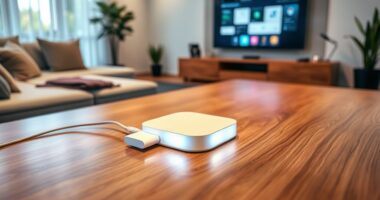Yes, you can integrate some Thread-enabled smart lights into Apple HomeKit without a hub, but full features like automation and voice control often depend on the device’s support and firmware. While many newer lights support direct pairing and simple control, reliable performance and seamless connectivity might be limited without a hub. For a complete understanding of how to make the most of your setup, there’s more to explore below.
Key Takeaways
- Many Thread-compatible smart lights support direct pairing with Apple HomeKit without needing a hub.
- Firmware and device support are crucial for enabling hub-free integration into HomeKit.
- Compatibility varies; verify if the specific smart light model is officially supported by HomeKit.
- Mesh network stability without a hub may be limited, especially in larger or complex homes.
- Full automation and voice control features might require additional hub or compatible devices.
Understanding Thread Technology and Its Benefits
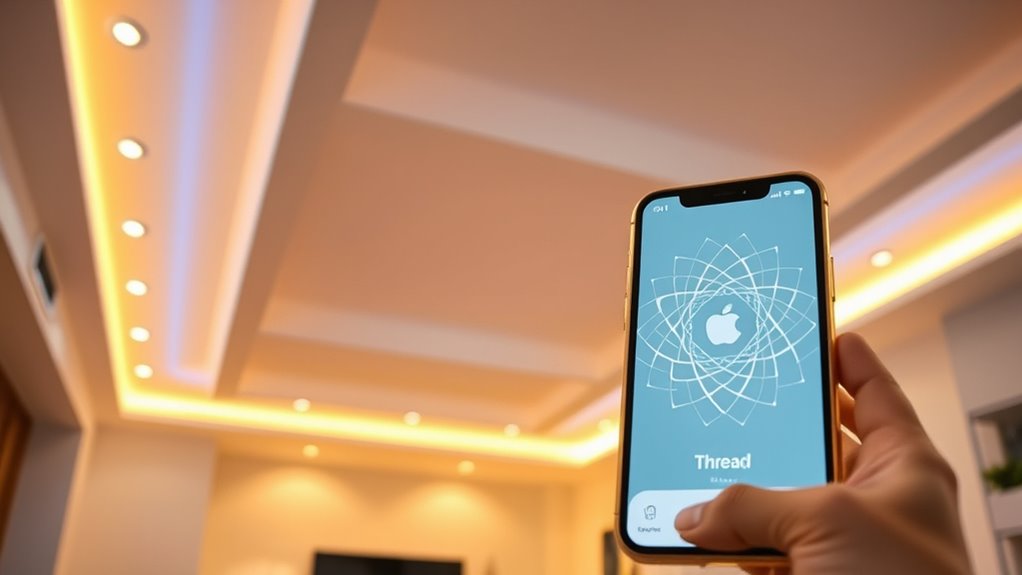
To understand how Thread technology enhances smart lighting, it’s important to recognize that it’s a low-power, secure, and reliable wireless protocol designed specifically for home automation. Unlike traditional wireless protocols, Thread prioritizes energy efficiency, helping your devices conserve power while maintaining a stable connection. This means your smart lights can operate longer on less energy, reducing your overall energy consumption and saving you money. Thread creates a mesh network, so signals bounce between multiple devices, ensuring consistent communication even if one device drops out. Its security features protect your network from unauthorized access, giving you peace of mind. Additionally, the mesh network architecture allows for scalable and flexible device placement throughout your home. Overall, Thread’s combination of energy efficiency, security, and reliable connectivity makes it an ideal choice for smart lighting systems in your home.
Compatibility of Thread Devices With Apple Homekit
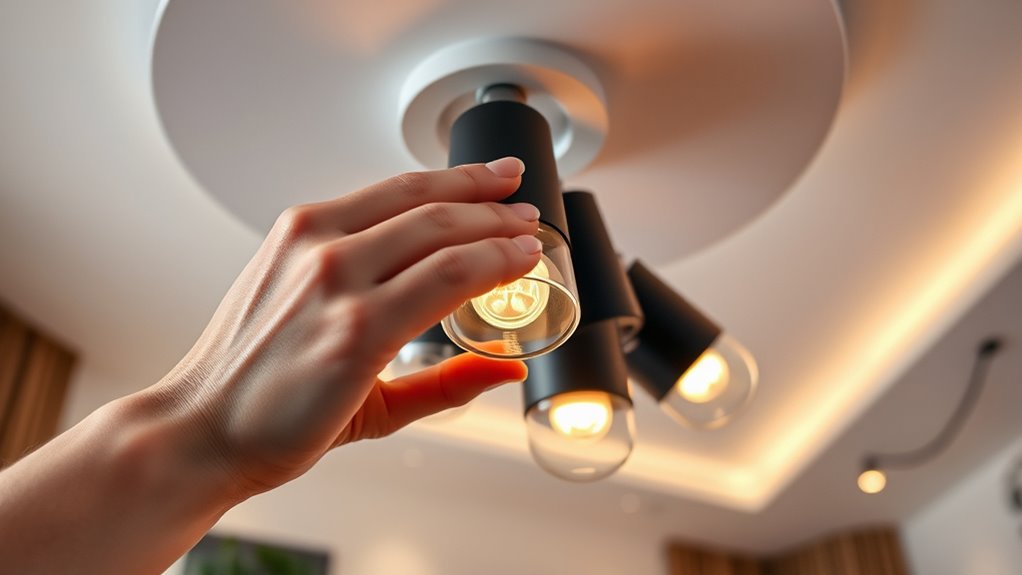
Because Thread devices are designed with modern smart homes in mind, they are increasingly compatible with Apple HomeKit, making integration seamless. This enhanced device interoperability allows you to add Thread-enabled products, like smart lights, directly into your HomeKit ecosystem without complicated setups. As a result, you can control your devices through the Apple Home app or Siri, ensuring a smooth user experience. Most new Thread devices support HomeKit natively, so you don’t need additional hubs or bridges. This compatibility simplifies expanding your smart home, giving you reliable, low-latency connections. However, it’s essential to verify that specific devices are officially compatible with HomeKit to avoid compatibility issues. Overall, Thread’s growing ecosystem aligns well with HomeKit’s standards, making your smart home more integrated and user-friendly.
Current State of Thread-Enabled Smart Lights
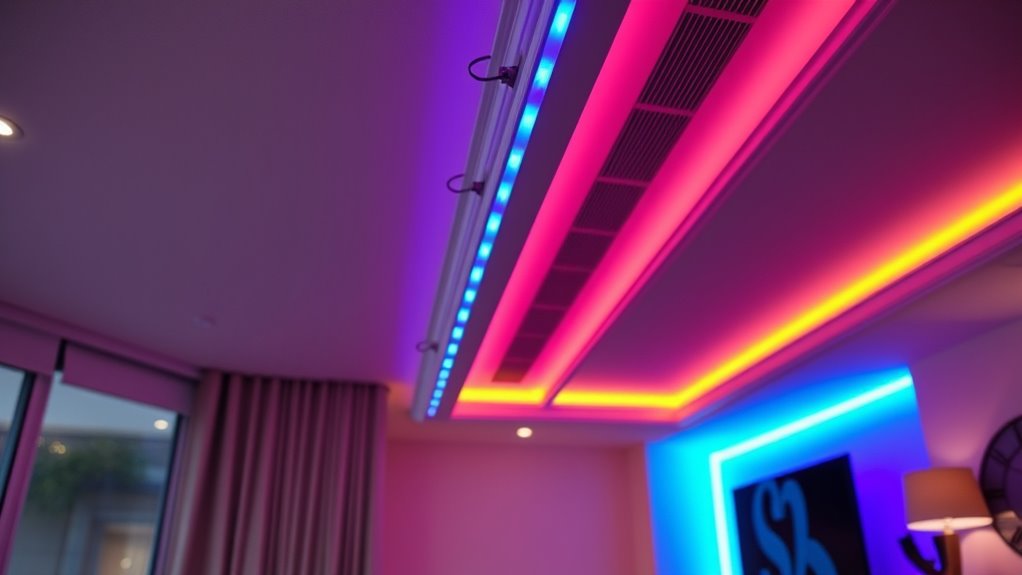
The current state of Thread-enabled smart lights shows significant progress in both availability and functionality. Today, many brands support Thread, making it easier to integrate with your existing smart home setup. These lights often work seamlessly with Apple Homekit, even without relying on legacy systems like hubs, offering more direct control. You can enjoy faster response times and more reliable connections thanks to the mesh networking capabilities of Thread. Additionally, manufacturers are prioritizing user customization, allowing you to personalize brightness, color, and scheduling options effortlessly. This flexibility enhances your smart lighting experience, making it more intuitive and tailored to your preferences. Overall, Thread-enabled smart lights are becoming more accessible and sophisticated, pushing toward a future where hub-free integration is not only possible but practical.
Direct Integration: Is It Feasible Without a Hub?
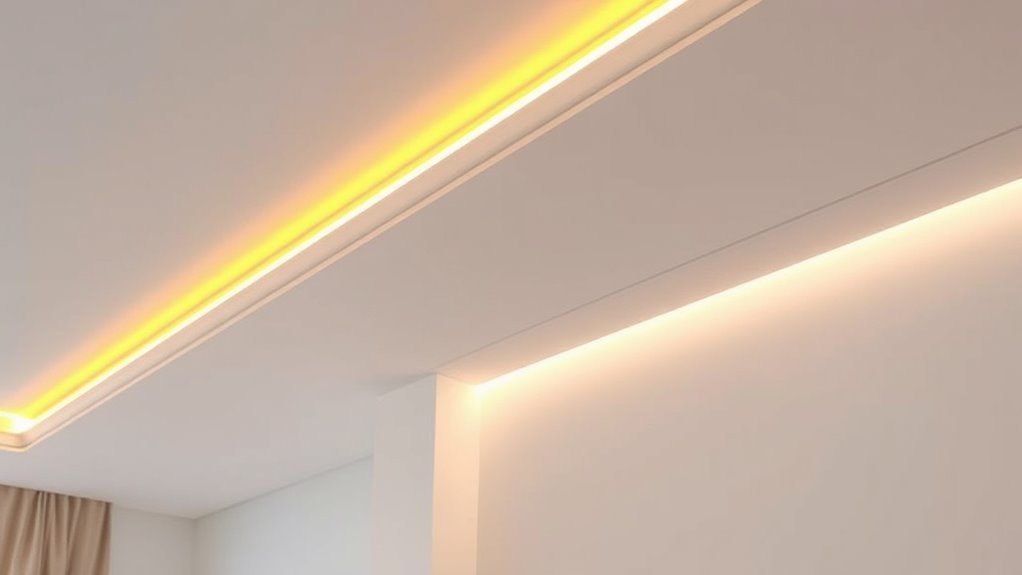
With Thread-enabled smart lights becoming more common, many users wonder if they can connect these devices directly to Homekit without relying on a hub. While some Thread lights support direct pairing, full integration for voice control and energy efficiency often still requires a hub. Not all devices are equal, and compatibility varies. Additionally, smart home protocols can influence the ease of setup and functionality.
Setting Up Thread Lights in a Homekit Ecosystem
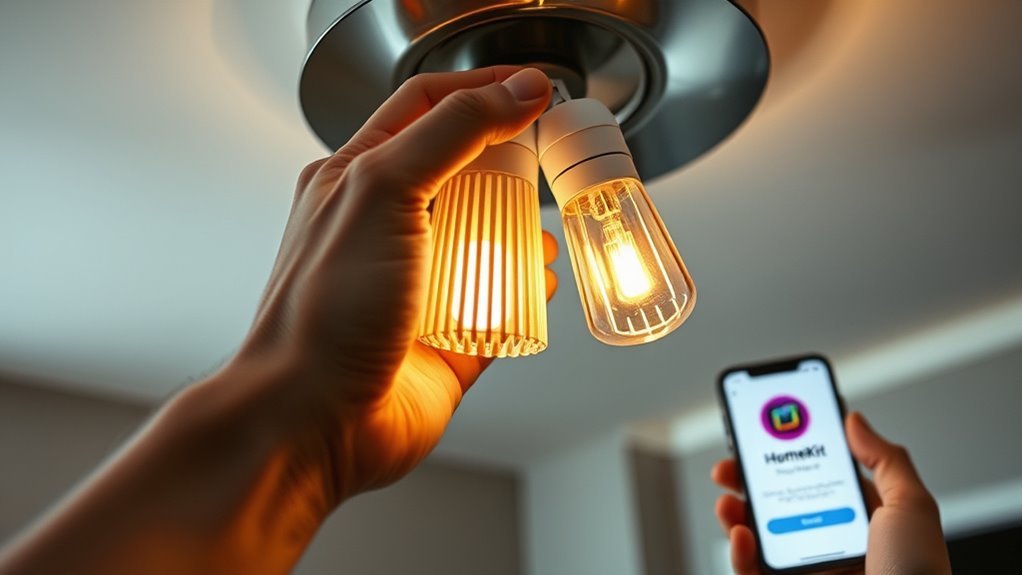
To establish your Thread lights in a Homekit ecosystem, you’ll need compatible devices that support Thread technology. Follow a clear, step-by-step installation process to guarantee everything connects smoothly. Once set up, you’ll enjoy seamless control and automation through the Home app. Additionally, understanding the Gold IRA options can help diversify your investment portfolio if you’re considering long-term planning.
Compatible Devices Needed
Setting up Thread lights in your HomeKit ecosystem requires compatible devices that support the Thread protocol. Without these, seamless integration and reliable communication are impossible. To guarantee smooth operation, focus on devices that prioritize voice control and energy efficiency. For example, electric bikes with high horsepower demonstrate the importance of selecting powerful and efficient components, which is similarly critical when choosing smart home devices. Here are the key device types you’ll need:
- Thread-enabled smart bulbs or fixtures — These form the core of your lighting setup.
- HomeKit-compatible controllers or bridges — They facilitate communication between Thread devices and your ecosystem.
- Voice assistants integrated with HomeKit — Enable hands-free control and enhance user experience.
- Energy-efficient devices — Save power while maintaining optimal brightness and performance.
Choosing compatible devices ensures your smart lights are reliable, easy to control, and energy-conscious.
Step-by-Step Installation Guide
Once you’ve selected compatible Thread-enabled smart bulbs and controllers, the next step is to physically install and connect them to your home network. Start by screwing in the bulbs and ensuring they’re powered on. Use your smartphone or the smart home app to connect each bulb to your Wi-Fi network, making sure they support Thread for seamless communication. Once connected, add the bulbs to your HomeKit setup by scanning the QR code or entering the setup code. This allows voice control through Siri, enabling you to turn lights on or off and adjust brightness easily. Since Thread is designed for energy efficiency, these bulbs consume less power while providing reliable, real-time control. Proper network configuration and ensuring your devices are up-to-date with firmware can improve overall stability and performance. Follow the app instructions to complete setup, ensuring your smart lighting system integrates smoothly into your HomeKit ecosystem.
Limitations and Challenges of Using Thread Without a Hub

While using Thread without a hub offers convenience, it comes with some notable limitations. Compatibility issues may arise with certain devices, and network stability can be a concern in busy or large homes. Understanding these challenges helps you set realistic expectations for your smart lighting setup. Additionally, Kia Tuning modifications highlight the importance of ensuring your system components are compatible and optimized for best performance.
Compatibility Limitations Persist
Despite the promise of seamless integration, using Thread smart lights without a dedicated hub still faces compatibility limitations. Not all devices support Thread, which means your options may be limited. This affects voice control, making it harder to manage lights through Siri or other assistants. Energy efficiency features can also be inconsistent if devices aren’t fully compatible within the Thread ecosystem. Additionally, creating a cohesive design can be challenging without proper device support, which impacts the overall smart home aesthetic and functionality.
Here are four key points to contemplate:
- Limited device support restricts pairing options.
- Compatibility varies across different brands and models.
- Firmware updates may be necessary for full functionality.
- Some features, like advanced automation, may not work without a hub.
You might find yourself frustrated by these restrictions, especially if you want a truly integrated smart home experience.
Network Stability Concerns
Using Thread smart lights without a hub can lead to network stability issues that disrupt reliable operation. Because Thread relies on mesh networking, each device communicates directly with its neighbors, creating multiple pathways for data. However, this setup can be vulnerable to signal interference from Wi-Fi routers, microwaves, or thick walls, which weaken connections. If a device drops out or loses power, the mesh network’s integrity suffers, potentially causing delays or failures in lighting control. Without a central hub to coordinate traffic, the network depends heavily on each device’s connection quality. As a result, you might experience inconsistent performance, especially in larger setups or homes with challenging layouts. Ensuring stable operation requires careful placement and minimizing sources of signal interference.
Future Prospects for Hub-Free Thread Smart Lighting
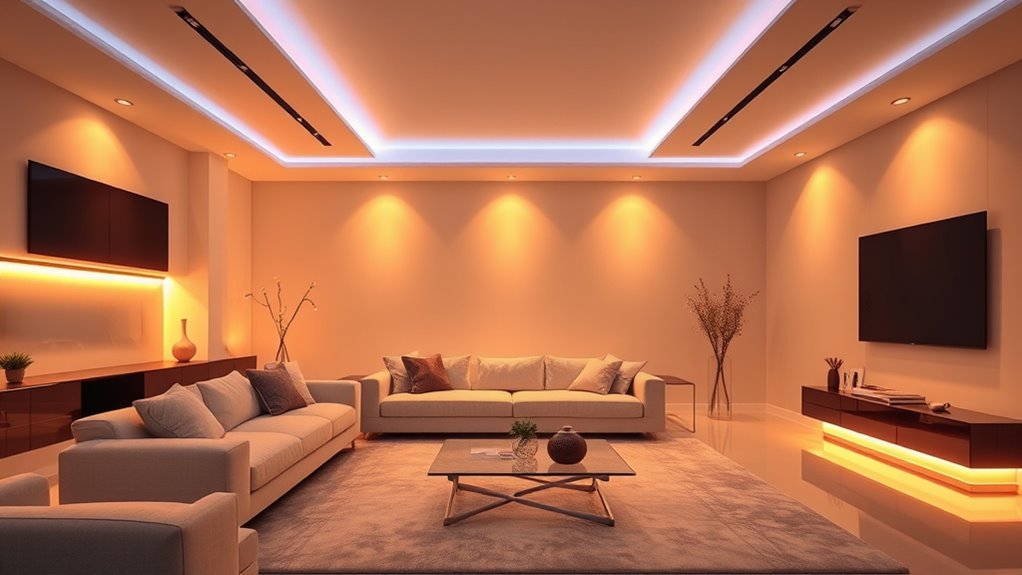
As technology advances, the future of hub-free Thread smart lighting looks promising, with manufacturers working to simplify setup and improve device interoperability. The use of wireless mesh networks will become more widespread, enhancing reliability and coverage for smart lights without a hub. You can expect easier integration with existing smart home systems, making setup more intuitive. Improved device interoperability will allow more brands and products to work seamlessly together, reducing compatibility issues. Additionally, advancements in firmware and standards will foster a more unified ecosystem, making your smart lighting smarter and more responsive. These developments suggest a future where you enjoy effortless control, stable connections, and a truly interconnected smart home environment. Here are some key insights:
- Enhanced reliability with wireless mesh
- Simplified setup processes
- Broader device interoperability
- Seamless integration across platforms
A growing emphasis on compatibility will further streamline how devices communicate and function within your smart home.
Frequently Asked Questions
Can Existing Smart Lights Be Upgraded to Support Thread Without a Hub?
You can’t upgrade existing smart lights to support Thread without a hub directly, as most require new hardware with Thread capabilities. However, you can choose Thread-compatible smart lights to enable seamless voice control and improved energy efficiency. Using a Thread-enabled hub or bridge allows these lights to integrate into your HomeKit system, enhancing control and reducing energy consumption, all while supporting future-proof smart home technology.
What Security Features Does Thread Technology Offer for Home Lighting?
Ever wonder how your smart lights protect your privacy? Thread technology uses robust encryption standards, like AES-128, ensuring your data stays secure from hackers. It also employs secure device onboarding and authentication, reducing privacy concerns. With these features, your home lighting network becomes safer, giving you peace of mind. Isn’t it reassuring to know that your smart lighting system prioritizes security as much as convenience?
Are There Specific Brands That Support Hub-Free Thread Integration With Homekit?
You wonder if any brands support hub-free Thread integration with HomeKit. Some brands, like Eve, focus on device integration that doesn’t require a hub, offering seamless compatibility with Thread. However, brand compatibility varies, so you’ll want to check each product’s specifications to verify it supports hub-free Thread technology and works directly with HomeKit. This way, you get the benefits of smart lighting without extra hub devices.
How Does Thread Compare to Zigbee or Z-Wave for Smart Lighting?
You’ll find that Thread offers better network reliability and higher energy efficiency than Zigbee or Z-Wave. It uses IPv6, allowing devices to connect directly to your home network, reducing latency and improving stability. Zigbee and Z-Wave rely on a mesh network, which can sometimes weaken with device loss. Overall, Thread’s modern design makes it more reliable and energy-efficient for smart lighting, especially in larger setups.
Will Software Updates Enable More Hub-Free Thread Devices in the Future?
You wonder if software updates will bring more hub-free Thread devices in the future. Firmware enhancements often improve device compatibility, making it easier for Thread smart lights to connect directly without hubs. As manufacturers continue to refine firmware, expect increased support for hub-free operation, expanding your options for seamless, reliable smart lighting. While current devices may need hubs, future updates could release greater compatibility and simplicity.
Conclusion
While it’s tempting to skip the hub and go direct, threading smart lights into HomeKit without one still faces hurdles. You need compatibility, you need support, and you need patience. But if you’re willing to navigate the limitations, stay informed about updates, and embrace new technology, you might just release a seamless, hub-free smart lighting experience. Keep exploring, keep adapting—because the future of smart homes is evolving, and you’re part of that journey.
